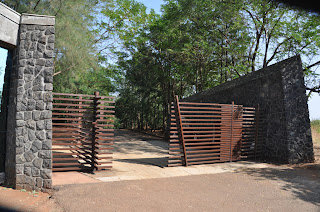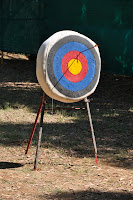For long we wanted
to visit Gir Forest. Last winter during Christmas the plan was almost firmed up
but somehow plan fell apart. Beginning this year we finally set out for a visit
to Junagadh and Gir Forest.
Mumbai to Junagadh
is approx. 950 Km. by road. We travel from Mumbai on NH-8 till Karjan and suddenly
decided to give the traditional route to reach Vataman via Vasad a miss. We
turned left from Karjan towards Padra to reach Borsad via Bhadaran. From
Borsad we drove towards Bagodara via Dharmaj, Tarapur & Vataman. This road
is being widened and many fly overs were being constructed. Therefore it had
many diversions and a few patches of bad road till Bagodara. As we turned left
on NH-8B from Bagodara we saw sign board indicating Lothal. It was approx. 20
Km detour but it brought back memories of Dholavira site we visited a few years
back.
Lothal was a small
village next to the river and had a harbour facilitating trade. Meaning of
Lothal in Gujarati is "the mound of the dead”. This Harappan Civilisation village
seemed to be divided into two parts. In one part we could see baths, drains and
water well. On the other part we could see a street with residential area on
either side of street. It is believed that the village was destroyed by sudden
floods leaving many dead.
After visiting
Lothal, we were back on track and continued our journey towards Junagadh via
Rajkot. HFM food mall on the way is a good place to halt with quite good
options like Havemore Food Plaza, CCD, Dominos, Sweet Shop, Traditional
Gijarati Food shop etc.
Finally we reached
Junagadh but had no prior booking at any hotel in the city. As we entered the
city, we saw Hotel Ashirwad in our right. As always, our luck prevailed and we
could not only secure accommodation but also could extract discounts on
published rates!! The rooms are very good and service is also up to the mark.
After checking in, we headed towards restaurant inside the hotel. Food was
tasty and reasonably priced.
The first visit in
Junagadh (Gadh or Kot in Gujarati means Fort therefore Junagadh means "Old
Fort") was to The Mohabat Maqbara, a palace-mausoleum and an exquisite
example the nineteenth-century art and architecture. It houses the tombs of Mohabbat Khanji. It's a
magnificent structure resembling somewhat The Taj. It is a masterpiece of its
kind with finely designed arches, vertical columns and elaborate stone carvings
on the walls and windows. It has decorated portals, the winding staircases
encircling its four tall minarets. A monument must see when in Junagadh. The
Jami Masjid and a Municipal School is on one side of the mausoleum while the Bahauddin
Maqbara (of Bahaduddinbhai Hasainbhai, Vazir of Nawab Rasul Khanji) is on the
other.
We witnessed a Muslim
wedding taking place inside the masjid with only groom being present. We are
told that only groom and witnesses visit the masjid after bride pronounce
‘Qubool Hai’ (Which means ‘I accept’)
Since the fort is
situated on a plateau, its termed as Uparkot. (Upar means Up or Above). It's an
ancient fort in the middle of town. Mount Girnar is visible from the fort. Fort
is double walled and a deep valley separates both. This acted as buffer in case
enemy breaches outer periphery. At foot of the palace we could see an escape
tunnel to avoid getting caught in case enemy enters the fort. The fort had facilities
to store water and food that could last many years. The fort was attacked 16
times and one such attack lasted twelve years.
Ranakdevi’s
marriage was fixed with one of the Sorath Kind Raja Jaisinh. However, Ranak was
in love with Ra-Khengar and they both were hiding in the Uparkot. Jaisinh
attacked the fort and the battle lasted 12 years!! People could survive the
attack because of water and food storage facilities built inside the fort.
Two canons named
Nilam and Manek, Adikadi Vaav (Vaav means Step Well), Navghan Kuvo (Kuvo means
Well), Buddhist Cave, Storage Tanks etc are main attraction inside Uparkot.
Adikadi Vaav is
long and windy. As we started climbing down the steps, a cool breeze emerged
from opposite direction. Textures on both sides of well makes you wonder
whether it’s carved out due to water levels or due to construction work of the
well.
City Museum was
next on the list. It displays many magnificent chandeliers, Thorn of the Nawab,
Medals, Weapons, etc. A private collector had displayed Stamp Papers of many
states of olden time. We were fortunate to spend some time chit chatting with
the stamp paper collector.
Other places to visit in Junagadh City:
- Narsinh Mehta no Choro - This place is said to be one where the great poet Narsinh Mehta held his assemblies of discovers in 15th century.
- Sakkar Bag Zoo – Founded in 1860 and probably the first zoo of India.
- Ashok's Edicts. An inscription with fourteen Edicts of Ashoka is found on a large boulder. The inscriptions carry Brahmi script (a language similar to Pali)
-
- Willingdon Dam - The dam is built on the river Kalwa at the foot of the hill. It was named after Lord Willingdon, the then Governor of India. Could drive our car right at top
-
- Bahauddin College. A fine architecture. Built by Nawab of Junagadh using his personal wealth and donations from other friends.
-
- Khapra Khodia Cave and Baba Pyara Cave. Two Buddhist Caves in Junagadh.
After spending two days in Junagadh, we headed towards Sansan Gir via Mendarda and checked in to The Taj Gateway Gir Forest. The hotel is situated right on river bank. Gir Forest is right across the river.
Spent the afternoon
leisurely in Tea Lounge and enjoyed cool breeze, nature and books. In the
evening, we set out for a stroll on river front and could spot many birds
including White Kingfisher and Peacock.
There are many stay
options in and around Sansan. The Fern is most beautiful resort where one has
an option to stay inside tent or villas. Possibly it’s the only 5-Start resort
in entire Saurashtra. Birding Lodge is another good property one kilometre off
main road and adjacent to Bhambhafod check post.
Next day was the
day we were waiting for quite long. It was a day to go for Jungle Safari in an
open jeep. There are two Jungle Safari options available, one Gir Jungle Trail
and the other one Devalia Safari Park. Both are distinct and different from
each other.
Devalia Safari Park
is a small jungle area within Gir Forest where a few Asiatic Lions are
captivated in open. In here you are taken in a bus and you are sure to spot
lions. Whereas Gir Jungle Trail is to be carried out in a large forest area of
approx. 1400 Sq. Km. You are permitted to enter core jungle area in an open
jeep with trained driver and guide. The permit is valid for three hours and you
need loads of luck to spot a lion.
Issuing forest
entry permits for 0900 Hrs slot starts at 0700 hrs. and very limited permits
are issued. So woke up real early and reached Sinh Sadan at 0630 Hrs. Process
of obtaining permit is simple and quick. Pay for number of persons as well as
camera and a computerised pass is issued. The permits are also issued on-line
in advance. Visit www.girllions.in to obtain e-permits.
There are many
safari tracks inside the Gir Forest. The guide and track is randomly assigned
while generating computerised permit. Depending on the track assigned, the
entry point for entering into the forest is decided.
It is said that for
a good jungle safari, one must be friendly with Jeep Driver and The Guide.
Friendly approach and our inquisitiveness motivate them which help not only
spotting Asiatic Lions but many other animals & birds.
We set out for an
exciting jungle safari in The Gateway Hotel’s open jeep driven by Dharmendra.
Narendra was our guide assigned by Forest department. Anvesh and Sonal staying
in same hotel too joined us in open jeep. Both of them are wild life enthusiast
as a result we could instantly connect with them and became friends.
Track-2 assigned to
us for the safari and therefore entered the jungle from Bhambhafod check post. Experience
of driving in jungle in an open jeep on a chilli winter morning is difficult to
explain. As we drove on kuchha road, Narendra
explained about Gir Forest, its wild life, the villages situated inside. Our
friendly demand was not just to spot lions but also other animals like Leopard,
Spotted Deers, Hyena and birds like Owls, Falcons, and Kingfishers etc. Sensing
our enthusiasm he promised to help us spot as many animals & birds as
possible. No sooner he promised, he pointed us towards an Owl perfectly
camouflaged sitting inside a hole in the tree trunk. Except Narendra’s trained
eyes, none of us spot the owl. Finally I offered him my camera and asked him to
click pictures.
As we drove
further, we spotted pug marks of lions. Looking at pug marks, Narendra deduced
that lions would have passed through the road a few hours before. Next we could
see many Spotted Deer, both male and female (Male Deer have long horn) roaming
freely in the wild. A family of Monkey were jumping from one tree to another. A
Kingfisher resting on a piece of wood situated inside a shallow water pond.
We were driving
inside the jugle for about two hours now and were little dejected for not
spotting a lion so far. As our jeep took
a one of the turns on Track-2, all of a sudden we spotted a female lion
crossing our path at some distance. We all were thrilled and our DSLR was
working overtime. After a while, our guide heard few more roars and turned out
to be two pairs of lions (two male and two female) resting under shadow of one
large tree. It was a successful ride with spotting of four lions.
Once back at hotel,
Anvesh joined us over lunch. During lunch, we all decided to cross
river outside hotel and take a stroll inside the jungle situated across the
river. We did just as we decided and had pleasure of jungle safari on foot!! Spent
almost an hour and half walking a little inside periphery of the jungle. We
could spot a herd of Spotted Deer. Spotting animals from open jeep and that
when you are of your own “jungle safari on foot” is two different experiences. Railway
line crossing the jungle was some distance away and we wanted to walk till we reach
the tracks. But we were tired and decided to rest on river bank enjoying
evening breeze, birds flying & chirping. Water level was not very high and
therefore on our way back we crossed the river on bare foot. This amazing
experience was possible because of location advantage The Gateway has.
It was out last day
at Gir. Next day we left for Surat whereas Anvesh had one more day
to enjoy. Therefore they both decided to repeat the adventure of “jungle safari
on foot”. We would have travelled for about an hour it’s when Anvesh called us.
His voice was full of excitement. Believe it or not they spotted a Lion just a
few meters away from them. In the moment of excitement and bit of fear, they
forgot that they had a camera with telephoto lense!!!
We continued our
journey back to Surat via Mendardara, Amreli, Botad, Dhandhka, Vataman,
Tarapur, Borsad, Vasad and Baroda.



































































